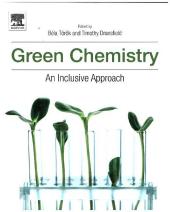 Neuerscheinungen 2017Stand: 2020-02-01 |
Schnellsuche
ISBN/Stichwort/Autor
|
Herderstraße 10
10625 Berlin
Tel.: 030 315 714 16
Fax 030 315 714 14
info@buchspektrum.de |

Timothy Dransfield, Bela Torok
(Beteiligte)
Green Chemistry
An Inclusive Approach
Herausgegeben von Torok, Bela; Dransfield, Timothy
2017. 1058 S. 235 mm
Verlag/Jahr: ELSEVIER 2017
ISBN: 0-12-809270-X (012809270X)
Neue ISBN: 978-0-12-809270-5 (9780128092705)
Preis und Lieferzeit: Bitte klicken
Green Chemistry: An Inclusive Approach provides a broad overview of green chemistry for researchers from either an environmental science or chemistry background, starting at a more elementary level, incorporating more advanced concepts, and including more chemistry as the book progresses. Every chapter includes recent, state-of-the-art references, in particular, review articles, to introduce researchers to this field of interest and provide them with information that can be easily built upon.
By bringing together experts in multiple subdisciplines of green chemistry, the editors have curated a single central resource for an introduction to the discipline as a whole. Topics include a broad array of research fields, including the chemistry of Earth´s atmosphere, water and soil, the synthesis of fine chemicals, and sections on pharmaceuticals, plastics, energy related issues (energy storage, fuel cells, solar, and wind energy conversion etc., greenhouse gases and their handling, chemical toxicology issues of everyday products (from perfumes to detergents or clothing), and environmental policy issues.
Introduces the topic of green chemistry with an overview of key concepts
Expands upon presented concepts with the latest research and applications, providing both the breadth and depth researchers need
Includes a broad range of application based problems to make the content accessible for professional researchers and undergraduate and graduate students
Authored by experts in a broad range of fields, providing insider information on the aspects or challenges of a given field that are most important and urgent
1. Introduction 1.1 Green Chemistry: Historical Perspectives and Basic Concepts
2. Chemical Issues of Modern Society 2.1 Environmental Chemistry, Renewable Energy and Global Policy 2.2 Sustainable Synthesis 2.3. Integrating the Principles of Toxicology Into a Chemistry Curriculum 2.4 Effects of Environmental Factors on DNA: damage and mutations
3. Green Chemistry in Practice 3.1. The Natural Atmosphere 3.2. Air Pollution and Air Quality 3.3. Stratospheric Ozone Depletion and Recovery 3.4. The Greenhouse Effect, Aerosols, and Climate Change 3.5. The Chemistry of Natural Waters 3.6. Water Contamination and Pollution 3.7. Contaminants of Emerging Concern, with an Emphasis on Nanomaterials and Pharmaceuticals 3.8. Pollution in the Coastal Zone: A Case Study of Wastewater on Cape Cod, MA 3.9. The Composition of Soils and Sediments 3.10. Heavy Metal Pollution and Remediation 3.11. Application of Green Chemistry in Homogeneous Catalysis 3.12. Heterogeneous Catalysis: A Fundamental Pillar of Sustainable Synthesis 3.13. Phase Transfer Catalysis: a Tool for Environmentally Benign Synthesis 3.14. Biocatalysis: Nature´s Chemical Toolbox 3.15. Organic Solvents in Sustainable Synthesis and Engineering by 3.16. Ionic liquids as novel media and catalysts for electrophilic/onium ion chemistry and metal-mediated reactions 3.17. Solvent-free synthesis of nanoparticles 3.18. Application of Microwaves in Sustainable Organic Synthesis 3.19. Application of Sonochemical Activation in Green Synthesis 3.20. Principles of Electrocatalysis 3.21. Principles of Photochemical Activation toward Artificial Photosynthesis and Organic Transformations 3.22. Biopolymers: biodegradable alternatives to traditional plastics 3.23. Modern Applications of Green Chemistry: Renewable Energy 3.24. From ethanol to biodiesel: a survey of green fuels 3.25. Solar Energy Conversion 3.26. Towards a Sustainable Carbon Cycle: the Methanol Economy 3.27. Natural and Nature-Inspired Synthetic Small Molecule Antioxidants in the Context of Green Chemistry 3.28. The Value-adding Connections between the Management of Eco-innovation and the Principles of Green Chemistry and Engineering 3.29. The International Chemicals Regime: Protecting Health and the Environment


